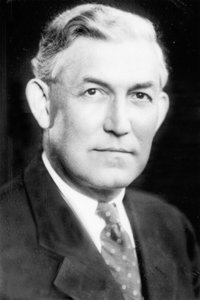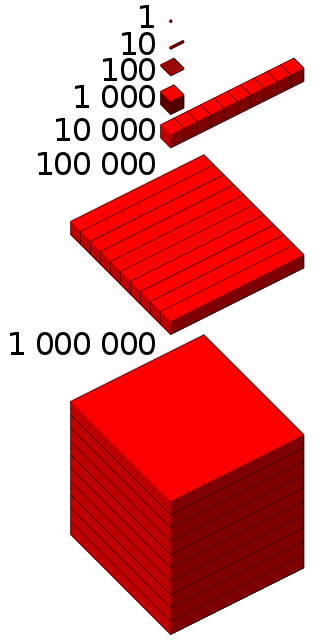
In number theory, a Carmichael number is a composite number , which in modular arithmetic satisfies the congruence relation:

In arithmetic and number theory, the least common multiple, lowest common multiple, or smallest common multiple of two integers a and b, usually denoted by lcm(a, b), is the smallest positive integer that is divisible by both a and b. Since division of integers by zero is undefined, this definition has meaning only if a and b are both different from zero. However, some authors define lcm(a,0) as 0 for all a, since 0 is the only common multiple of a and 0.
In mathematics, a Mersenne prime is a prime number that is one less than a power of two. That is, it is a prime number of the form Mn = 2n − 1 for some integer n. They are named after Marin Mersenne, a French Minim friar, who studied them in the early 17th century. If n is a composite number then so is 2n − 1. Therefore, an equivalent definition of the Mersenne primes is that they are the prime numbers of the form Mp = 2p − 1 for some prime p.

A prime number is a natural number greater than 1 that is not a product of two smaller natural numbers. A natural number greater than 1 that is not prime is called a composite number. For example, 5 is prime because the only ways of writing it as a product, 1 × 5 or 5 × 1, involve 5 itself. However, 4 is composite because it is a product (2 × 2) in which both numbers are smaller than 4. Primes are central in number theory because of the fundamental theorem of arithmetic: every natural number greater than 1 is either a prime itself or can be factorized as a product of primes that is unique up to their order.

In mathematics, a divisor of an integer, also called a factor of , is an integer that may be multiplied by some integer to produce . In this case, one also says that is a multiple of An integer is divisible or evenly divisible by another integer if is a divisor of ; this implies dividing by leaves no remainder.
In number theory, a prime number p is a Sophie Germain prime if 2p + 1 is also prime. The number 2p + 1 associated with a Sophie Germain prime is called a safe prime. For example, 11 is a Sophie Germain prime and 2 × 11 + 1 = 23 is its associated safe prime. Sophie Germain primes are named after French mathematician Sophie Germain, who used them in her investigations of Fermat's Last Theorem. One attempt by Germain to prove Fermat’s Last Theorem was to let p be a prime number of the form 8k + 7 and to let n = p – 1. In this case, is unsolvable. Germain’s proof, however, remained unfinished. Through her attempts to solve Fermat's Last Theorem, Germain developed a result now known as Germain's Theorem which states that if p is an odd prime and 2p + 1 is also prime, then p must divide x, y, or z. Otherwise, . This case where p does not divide x, y, or z is called the first case. Sophie Germain’s work was the most progress achieved on Fermat’s last theorem at that time. Latter work by Kummer and others always divided the problem into first and second cases. Sophie Germain primes and safe primes have applications in public key cryptography and primality testing. It has been conjectured that there are infinitely many Sophie Germain primes, but this remains unproven.
In recreational mathematics, a repunit is a number like 11, 111, or 1111 that contains only the digit 1 — a more specific type of repdigit. The term stands for repeated unit and was coined in 1966 by Albert H. Beiler in his book Recreations in the Theory of Numbers.
In number theory, a Wieferich prime is a prime number p such that p2 divides 2p − 1 − 1, therefore connecting these primes with Fermat's little theorem, which states that every odd prime p divides 2p − 1 − 1. Wieferich primes were first described by Arthur Wieferich in 1909 in works pertaining to Fermat's Last Theorem, at which time both of Fermat's theorems were already well known to mathematicians.
In number theory, a Wall–Sun–Sun prime or Fibonacci–Wieferich prime is a certain kind of prime number which is conjectured to exist, although none are known.
In mathematics, a palindromic prime is a prime number that is also a palindromic number. Palindromicity depends on the base of the number system and its notational conventions, while primality is independent of such concerns. The first few decimal palindromic primes are:
300 is the natural number following 299 and preceding 301.
In number theory, a happy number is a number which eventually reaches 1 when replaced by the sum of the square of each digit. For instance, 13 is a happy number because , and . On the other hand, 4 is not a happy number because the sequence starting with and eventually reaches , the number that started the sequence, and so the process continues in an infinite cycle without ever reaching 1. A number which is not happy is called sad or unhappy.

One million (1,000,000), or one thousand thousand, is the natural number following 999,999 and preceding 1,000,001. The word is derived from the early Italian millione, from mille, "thousand", plus the augmentative suffix -one.

At the 1912 International Congress of Mathematicians, Edmund Landau listed four basic problems about prime numbers. These problems were characterised in his speech as "unattackable at the present state of mathematics" and are now known as Landau's problems. They are as follows:
- Goldbach's conjecture: Can every even integer greater than 2 be written as the sum of two primes?
- Twin prime conjecture: Are there infinitely many primes p such that p + 2 is prime?
- Legendre's conjecture: Does there always exist at least one prime between consecutive perfect squares?
- Are there infinitely many primes p such that p − 1 is a perfect square? In other words: Are there infinitely many primes of the form n2 + 1?

Wladimir Kaminer is a Russian-born German short story writer, columnist and disc jockey of Jewish origin, the son of Viktor and Shanna Kaminer.
5 (five) is a number, numeral and digit. It is the natural number, and cardinal number, following 4 and preceding 6, and is a prime number. It has garnered attention throughout history in part because distal extremities in humans typically contain five digits.
In mathematics, a Wieferich pair is a pair of prime numbers p and q that satisfy

Henry William "Heine" Meine, sometimes "Heinie" Meine, was a professional baseball player. Meine was a right-handed pitcher who played for the St. Louis Browns in 1922 and for the Pittsburgh Pirates from 1929 to 1934. He was given the nickname "The Count of Luxemburg" on account of his operating a speakeasy/tavern in the Luxemburg section of St. Louis. He led the National League in wins and innings pitched in 1931 and compiled a 66–50 record in seven seasons of Major League Baseball.
A repeating decimal or recurring decimal is decimal representation of a number whose digits are periodic and the infinitely repeated portion is not zero. It can be shown that a number is rational if and only if its decimal representation is repeating or terminating. For example, the decimal representation of 1/3 becomes periodic just after the decimal point, repeating the single digit "3" forever, i.e. 0.333.... A more complicated example is 3227/555, whose decimal becomes periodic at the second digit following the decimal point and then repeats the sequence "144" forever, i.e. 5.8144144144.... At present, there is no single universally accepted notation or phrasing for repeating decimals.








